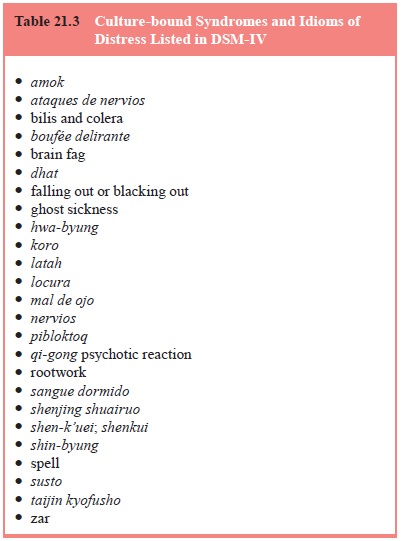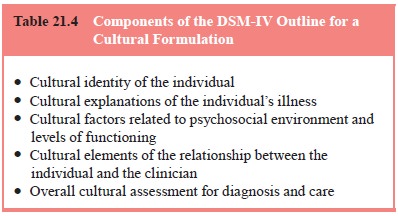Chapter: Essentials of Psychiatry: Cultural Aspects of Psychiatric Disorders
The Case of Culture-bound Syndromes and Idioms of Distress
The Case of Culture-bound
Syndromes and Idioms of Distress
Investigation of so-called culture-bound syndromes
was geared for decades toward incorporation of these “exotic’’ categories into
the Western nosologies (Simons and Hughes 1985). The term “culture-bound’’
(Table 21.3) was used to describe a certain number of psychiatric disorders
whose phenomenologies made them distinct from the Western categories and that
theoretically could be singled out as unique to a particular cultural setting
(Hughes et al., 1997). The clear
implication was that the West-ern categories were not culture-bound but rather
universal, and that proper characterization would disclose a translation key
for specific nonWestern syndromes. However, these conditions have been studied
more critically to understand instead the culture-bound nature of the Western
classification schemes themselves and to enable the appropriate treatment of
patients whose under-standings and presentation of illness conform to these
indigenous categories (Good, 1994; Good and Delvecchio Good, 1982).
Contemporary cultural psychiatry recognizes that
all clas-sification schemes are inherently cultural and subjects Western
nosologies to the same kind of social analysis that it continues to apply to
the indigenous nosologies (Lewis-Fernández and Kleinman, 1995). In this modern
sense, “cultural-bound syn-drome’’ is an inherited and controversial term that
is used in practice to describe psychiatric categories, whether they are part
of the Western or nonWestern nosologies, on whose emergence, manifestation, or
course culture is thought to exert a particu-larly strong influence (Hahn,
1985; Guarnaccia, 1993). The term continues to refer to relatively consistent
illness categories with characteristic courses (“syndromes’’) and specific
labels.

The organizing principle that unifies a syn-drome
conceptually can be 1) a collection of symptoms, which can follow diverse classificatory
schemes (descriptive); 2) a cause, including an immediate precipitating context
(etiological); or 3) a response to treatment (Good and Delvecchio Good, 1982).
“Idiom of distress’’ is a newer term, which was
coined to refer to a more general level of analysis (Nichter, 1981). Rather
than denoting specific syndromes, the term refers to the more gen-eral illness
“languages’’ of social groups, the culturally preferred ways of expressing
distress, such as by somatic complaints, psy-chologizing explanations,
possession or witchcraft terminology, oppositional or violent behavior
illnesses due to “nerves’’, or at-tributions of inexplicable misfortune. In
this sense, a given idiom of distress, such as somatization, can be expressed
as multiple culture-bound syndromes such as ataques
de nervios, neurasthe-nia, “brain fag’’, and so on. DSM-IV-TR presented a
substantial list of culture-bound syndromes and idioms of distress in one of
its appendices
Contemporary
use of this terminology allows us to under-stand certain difficulties in the
integration of the Western and nonWestern categories of psychiatric illness
(Lewis-Fernández, 1992; Wig, 1983). First, the Western nosologies are based at
present nearly exclusive on descriptive parameters. Wary of “the-oretical’’
causes, our current diagnostic system privileges a for-mal definition of
psychopathological processes. Most indigenous nosologies, on the other hand,
distinguish illness from normality at least as much on the basis of contextual
characteristics as on descriptive ones. These include assessments regarding
appropri-ateness of the symptom in the particular setting at the specific time
in question, the relative sufficiency of precipitating stres-sors, and the
nature and quality of the human relationships of the sufferer. These
discrepancies between the organizing principles of the Western and nonWestern
nosologies prevent an easy con-solidation of psychopathological criteria across
cultures.
Secondly, nosologies also differ in the
configurations of their phenomenologies (Kleinman, 1988; Weiss, 1996; Good and
Delvecchio Good, 1982). The symptoms of many culture-bound syndromes, such as amok in Malaysia, or ataque de nervios in Puerto Rico, are
composed of a variety of behavioral and experi-ential elements that are
considered by the Western nosologists to belong to separate diagnostic
categories. The characteristic pres-entations of these conditions exhibit
diverse combinations of dis-sociative, psychotic, anxiety, depressive,
characterological and somatic symptoms (Lewis-Fernández, 1992). Significant
phe-nomenological variation occurs among individual cases, which are
nevertheless unifying under a single nosological label.
These differences in definitions of illness and
phenomeno-logical organization between the Western and nonWestern cat-egories
ensure that the two nosologies are overlapping as global systems. From the
psychiatric perspective, a cohort of individu-als identified by a cohort
indigenous label will prove to be diag-nostically heterogeneous or even
nonpathological. The obverse is that almost homogeneous psychiatric cohorts
will appear locally verse. A nomographical, one-to-one relationship between the
Western and nonWestern nosologies appears thus unattainable (Weiss, 1996). What
is achievable is the systematic characteriza-tion of individual cases of
persons suffering from culture-bound syndromes in terms of the Western
categories of psychiatric illness, retaining at the same time an account of
their distinct definitions of illness, idioms of distress, unique symptoms and
other associated factors in the form of a cultural formulation

(Mezzich and Good, 1997) (Table 21.4). This
iterative process of translation will result eventually in a comprehensive
cultural psychiatry that integrates diverse local and professional
classifi-cations of psychiatric illness with the goal of more effective
com-munication and care of patients.
In spite of the importance of including
culture-bound syn-dromes in the DSM-IV-TR, Guarnaccia and Rogler (1999) warn
that important methodological issues remain unaddressed, since DSM-IV-TR does
not include a system of norms to delimit the range of psychiatric disorders
that relate to particular culture-bound syndromes, nor include these cultural
conditions within the established disorder categories.
Related Topics